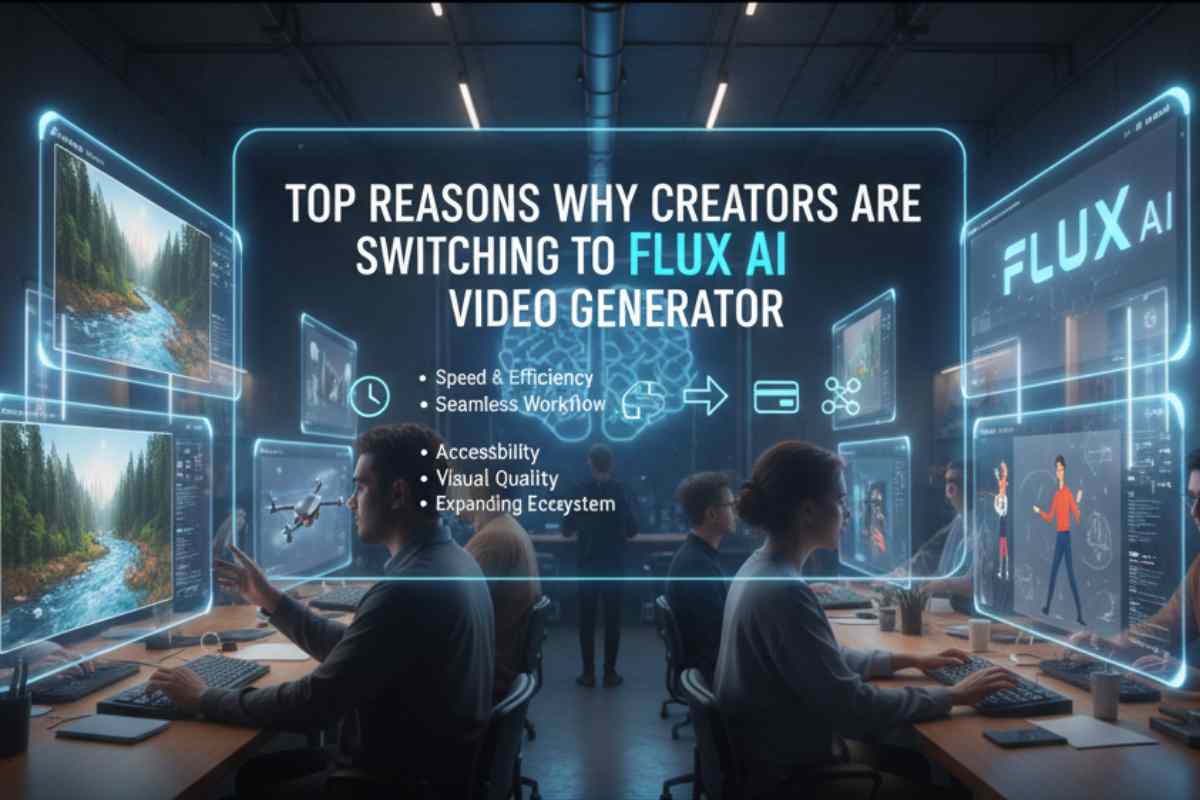In today’s rapidly evolving world of content creation, video has become the most powerful medium to capture attention, tell stories and engage audiences.
As artificial intelligence reshapes how visuals are made, one tool is gaining remarkable attention among creators: Flux AI Video Generator.
From animating still images to generating motion visuals from scratch, Flux is redefining how creators think about video production.
But what makes this tool so special? Why are so many creators switching to Flux AI over other popular AI video tools?
This article takes a deep, human and data-driven look into these questions exploring the technology, user benefits, comparisons and future of AI-powered video generation through the lens of Flux.
Understanding Flux AI Video Generator
Flux AI Video Generator is an emerging platform designed to transform static images into short, visually coherent videos.
Built upon the foundation of Flux.1, the highly regarded text-to-image model developed by Black Forest Labs, Flux extends its capabilities into motion, allowing users to create brief animations with impressive realism.
Unlike conventional video editors that require manual sequencing and layer management, Flux leverages deep learning to interpret visual cues from an image and simulate realistic motion like camera pans, zooms or character movement.
The result is a short but expressive video clip that feels alive, without the creator ever touching a complex editing timeline.
Flux’s growing popularity stems not only from its creative flexibility but also from its simplicity.
Whether it’s used by digital artists, agencies or social media managers, the learning curve is minimal compared to tools like Runway or Pika Labs.
This accessibility has made Flux a game-changer for creators who value speed and efficiency without sacrificing quality.
The Current Landscape of AI Video Generation
Before understanding why creators are switching to Flux, it’s worth looking at the broader context of AI video tools in 2025.
The industry has exploded with innovation, from text-to-video generators to advanced motion synthesis platforms. Yet, despite this progress, most AI video solutions still face common challenges: slow processing, inconsistent motion quality and high pricing models.
Competitors like Runway ML and Pika have introduced impressive video capabilities but often come with steep subscription costs and a learning curve that intimidates newcomers.
Others, such as DeepBrain or Lumen5, focus on text narration or avatar-based video, which appeals to marketers but not necessarily visual storytellers.
In this landscape, Flux fills a critical gap. It merges artistic control, affordability and speed into one package.
By focusing on image-to-video generation, Flux allows creators to build upon visuals they already have instead of generating motion entirely from text prompts.
This unique balance between creativity and practicality explains why so many creators are migrating toward Flux.
Why Creators Are Switching to Flux AI Video Generator?
Speed and Creative Efficiency
One of the strongest reasons creators are embracing Flux is its remarkable speed. Traditional video production involves numerous stages of storyboarding, editing, rendering which can consume hours or even days. Flux condenses this process into minutes by automating the motion generation phase.
Creators who previously spent half a day animating a product shot or Instagram post can now do it in a fraction of the time.
Because Flux’s AI works directly from static visuals, it bypasses heavy rendering and achieves smooth transitions almost instantly.
For digital marketers or freelancers managing multiple clients, this time efficiency translates directly into higher productivity and profitability.
Seamless Image-to-Video Workflow
Another major factor behind Flux’s growing popularity is its seamless integration with existing image workflows. Many creators already use AI tools like Midjourney, DALL·E or Flux.1 for generating visuals.
Flux AI Video Generator takes those still images and brings them to life through motion, eliminating the need to rebuild concepts from scratch.
This continuity is what makes Flux so appealing. For example, a brand designer who creates AI-generated images for an ad campaign can instantly convert those assets into moving scenes, saving both creative effort and technical complexity. It bridges the world of still design and video storytelling in one intuitive step.
Accessibility and Cost Flexibility
Cost has always been a barrier for many creators exploring AI video tools. High-end platforms charge premium rates for access to HD or 4K exports, making it difficult for small creators and startups to experiment freely.
Flux approaches this differently by offering a credit-based system and a free access tier, allowing new users to test its capabilities before committing to a subscription.
This flexible pricing has democratized AI video creation. Students, freelancers and small businesses can all experiment with professional-quality animation without upfront financial risk. It’s a strategic move that lowers the barrier to entry and fosters creative diversity within the Flux community.
Simplicity Without Sacrificing Control
While some AI video platforms pack extensive editing features, they can overwhelm users who simply want fast, creative results. Flux prioritizes simplicity without sacrificing artistic control. The interface focuses on what matters: uploading your image, defining motion parameters and generating output.
This design philosophy aligns perfectly with modern content workflows, especially for social media creators who prefer straightforward tools over advanced editing software.
Yet, despite its simplicity, Flux allows users to customize duration, resolution and movement intensity. It’s a balanced combination of automation and user control that keeps both beginners and professionals satisfied.
Visual Quality and Realism
The heart of any video generator lies in its visual output and this is where Flux truly excels. Drawing from its advanced diffusion-based image model, Flux produces crisp, coherent motion while maintaining fine details like lighting, texture and depth.
Unlike some AI tools that distort objects or faces when animating, Flux demonstrates remarkable consistency.
The AI preserves realism even in subtle motion sequences, which is especially valuable for portrait-based or product-focused videos.
This visual stability has convinced many professional creators to switch from experimental video models to Flux as their daily driver for short-form animation.
Expanding Ecosystem and Integration Potential
Flux AI Video Generator is not an isolated product, it’s part of a growing ecosystem. The developers at Black Forest Labs are continuously enhancing its capabilities and integrations, making Flux more versatile for future use cases.
Already, the model shows potential for integration with creative software, APIs and automation tools. As more creators adopt Flux, complementary plugins and community resources are emerging.
These integrations pave the way for end-to-end AI video pipelines where creators can generate, animate, edit and publish within one connected system.
Real-World Adoption: Examples of How Creators Use Flux
Flux’s rising adoption is driven by its proven performance in real-world workflows. Social media managers use it to transform static brand visuals into engaging reels or ad snippets.
Independent artists animate concept art to create immersive storytelling sequences without using 3D software. Small businesses leverage Flux to design animated promotional posts that attract attention without hiring video professionals.
For instance, a digital marketing agency reported that using Flux to animate static product photos increased client engagement on Instagram by 38%.
Similarly, a freelance creator who regularly posted AI-generated artwork began animating her visuals through Flux and saw a significant boost in reach across TikTok and YouTube Shorts. These examples show that Flux’s value isn’t theoretical, it’s delivering measurable creative results in practice.
How Flux Compares to Other AI Video Tools?
When compared to leading video generators like Runway ML, Pika and DeepBrain, Flux stands out for its ease of use and visual fidelity. Runway offers broader editing control and text-to-video options but requires higher system resources and subscriptions.
Pika specializes in short-form content but can struggle with fine details and realism. DeepBrain focuses on avatar-based content, which suits business explainers but not creative storytelling.
Flux finds its niche between these extremes. It delivers superior image coherence while maintaining speed and accessibility.
For creators who prioritize motion quality and simplicity over advanced editing complexity, Flux often emerges as the more practical and balanced choice.
This unique positioning explains why many creators are transitioning to Flux even when they already use other platforms.
Limitations and Challenges of Flux AI Video Generator
No AI tool is perfect and understanding Flux’s current limitations helps users adopt it wisely. One key limitation is video length Flux currently focuses on short clips, typically 5 to 15 seconds, making it unsuitable for long-form storytelling.
Additionally, while its image-to-video capabilities are impressive, it lacks integrated audio or voice synthesis features, requiring users to add sound in external editors.
Another challenge lies in advanced editing control. Flux prioritizes automation, which means you can’t manually tweak every motion frame or layer effects as deeply as in traditional editors.
The AI decides much of the motion path, which occasionally leads to unpredictable results. Nonetheless, for many creators seeking fast output, these limitations are a reasonable tradeoff for the efficiency and accessibility Flux provides.
Best Practices for Getting the Most from Flux AI Video Generator
To achieve the best results with Flux, creators should start with high-quality images. The clarity, resolution and composition of your input image directly influence how smooth and realistic the animation appears.
Subtle, natural motion tends to produce the most appealing results, as extreme movements can distort small details.
When working with storyboards or multi-frame inputs, ensure visual consistency between frames lighting, perspective and subject position should align closely.
This helps Flux generate cleaner transitions. For creators needing sound or voiceovers, exporting silent videos and layering audio later using tools like CapCut or Adobe Premiere ensures better control over the final output.
Experimentation is key. By adjusting Flux’s duration, creativity intensity or resolution settings, users can fine-tune results and discover unique visual effects.
As the platform continues to evolve, these flexible parameters will likely expand, giving creators even more control over their projects.
The Future of Flux AI and Its Role in Creative Media
Flux AI Video Generator represents more than just another AI product; it symbolizes a shift in how creators approach storytelling.
As artificial intelligence becomes more accessible, tools like Flux are democratizing creative expression. They enable individuals with minimal technical skills to produce cinematic visuals, closing the gap between imagination and execution.
In the near future, Flux is expected to introduce longer video durations, better temporal consistency and built-in audio synchronization.
Developers are also exploring open-source collaboration through Flux AI Video Generator GitHub resources, inviting creators and developers to contribute to the ecosystem.
These ongoing advancements suggest that Flux is not a temporary trend, it’s a foundational shift toward AI-driven creativity.
Conclusion
The growing migration of creators to Flux AI Video Generator is not surprising. It represents the perfect intersection of efficiency, creativity and accessibility.
By enabling users to animate images effortlessly, Flux empowers a new generation of creators to produce professional-quality video content faster than ever before.
For digital marketers, it’s a tool that saves time. For artists, it’s a creative partner. For small businesses, it’s a gateway to affordable video marketing.
And for the wider AI community, Flux marks a critical milestone in the evolution of visual generation technology.
As Flux continues to refine its video models and expand its ecosystem, the reasons creators are switching will only grow stronger. In a world where motion increasingly defines engagement, Flux stands out as the tool that lets creators move at the speed of imagination.
FAQ’s
Is Flux AI Video Generator free to use?
Flux AI offers both free and premium options. The free plan allows limited video generation, while premium tiers unlock higher resolution, longer clips and faster rendering.
How does Flux AI Video Generator differ from tools like Pika or Runway ML?
Flux AI stands out for its smooth motion rendering, image-to-video accuracy and open-source model available on GitHub features that balance power and accessibility.
Can I generate videos from text prompts using Flux AI?
Yes. Flux AI supports both image-to-video and text-to-video generation, allowing creators to describe a scene or upload visuals to bring them to life.
What are the system requirements for using Flux AI Video Generator?
Flux AI can be used on cloud-based platforms or locally with a compatible GPU. Most creators prefer the browser version for ease and speed.
Is Flux AI Video Generator suitable for commercial projects?
Absolutely. Many creators, marketers and studios use Flux AI for ads, product demos and social content, thanks to its realistic animation output and licensing options.
Where can I find Flux AI Video Generator updates or open-source code?
You can access official updates and open-source resources on the Flux AI GitHub repository, which includes model files, documentation and integration guides.


